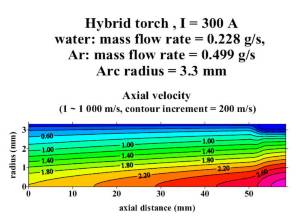|
Generation of Thermal Plasmas and Physics of Electric Arcs
Investigation of plasma spraying torches with liquid stabilization of arc, especially with water stabilization (WSP) and hybrid stabilization (WSPH), i.e. the combined stabilization of arc by axial gas flow (Ar, N2) and water vortex. Experimental and theoretical analysis of power and mass balances in the arc chamber. Improvement of the design of the plasma systems WSP® 2000 and WSP®H 2000 composed of the plasma torch, the water supply unit, the electrical power supply and the control unit (plus the gas-stabilized and the gas supply units in the WSP®H 2000 system).
Thermal Plasma Jets
Experimental measurements of basic properties (temperature, electron number density, flow velocity) of plasma jet generated by WSP® and WSP®H. Investigation of flow structure, instabilities, fluctuations and nonequilibrium effects.
Interaction of Thermal Plasma with Other Substances
Investigation of physical and chemical processes taking place during interaction of injected gaseous, liquid or solid substances with thermal plasma jet generated by WSP® (WSP®H). Study of plasma jet with an ambient atmosphere, entrainment of cold gas in thermal plasma jet. Investigation of a possibility of WSP® applications for new technologies (waste treatment, pyrolysis of biomass for syngas production, production of nanoparticles).
Electrode Phenomena in Arcs
Investigation of the anode attachment region of arc in plasma torches. Study of anode attachment motion and correlation with arc voltage fluctuations. Effect of anode attachment motion on fluctuations of plasma jet.
Plasma Diagnostics
The temperature of the plasma is measured by the optical emission spectroscopy; the alternative method usesthermocouples. Electric probes and system of photo-diodes are used for determination of the velocity of plasma flow, of propagation of perturbation and for visualization of plasma flow structure. The structure of flow field of plasma jet is visualized also by schlieren photography. High speed camera and fast shutter cameraswith synchronized measurement of arc voltage and current are used for investigation of the anode attachment motion and of changes of the jet structure. The velocity of individual particles injected into jet is measured by method based on photography by CCD cameras with multiple exposure and triggered shutter. Light fluctuations are studied with array of fast response photo-diodes. Enthalpy probe enables to study jet flow structure, fluctuation of the arc jet caused by arc root movement as well as transition of the jet from the subsonic regime to the supersonic one.
 |
Plasma Processing
Treatment of wastes and the reduction of pollution created by human activities using thermal plasma technology.
Pyrolysis and vitrification of solid substances in thermal plasma - production of syngas (H2, CO) from biomass. System PLASGAS for destruction of solid and liquid materials based on the hybrid water/argon plasma torch WSP®H 2000 (see the picture) built in 2004 at the Institute of Plasma Physics in cooperation with industrial partners in Belgium and the Czech Republic. The main features of this plasma device compared to conventional heat incinerators: 1) far higher temperatures (>4000 K) that can be reached by a conventional heat generator, 2) high energy density and high heat transfer efficiency, shorter residence times and large throughputs, 3) low thermal inertia, 4) absence of combustion gases generated by a conventional incinerators, 5) lower plasma gas input per unit heating power and thus lower energy loss corresponding to energy necessary for heating of gas to reaction temperature and lower amount of off-gases to be treated, 6) absence of combustion gases generated by a conventional incinerators, 7) smaller plants than for incinerators due to high energy densities, lower gas flows, volume reduction, 8) heat source is electrical energy rather than energy liberated from combustion, and is therefore independent of the treated material.
 |
Theoretical Description and Numerical Modeling of Arc Plasmas and Chemical Reactors
Theoretical description of processes in the electric arcs with water vortex and hybrid stabilizations under atmospheric pressure is investigated for several years. Two-dimensional numerical model of these arc discharges assumes that plasma flow is laminar, compressible, in the state of local thermodynamic equilibrium and in axisymmetric geometry configuration. Energy transport from the discharge by radiation is included either by the net emission coefficients or by the partial characteristics method for water or mixture of water-argon plasmas. Two numerical methods are applied for the solution of the set of the conservative equations (continuity, momentum, energy): 1) a compressible-modified finite-volume-based difference scheme with iteration procedure SIMPLER. 2) LU-SGS method with MUSCL-type TVD scheme for diffusion-convection terms. Large eddy simulation (Smagorinsky subgrid-scale model) is applied to capture possible turbulent behavior.
Modeling of the thermal plasma reactor PLASGAS for gasification and vitrification of waste and biomass based on the hybrid water-argon plasma torch WSP®H 2000. Two-dimensional modeling of mixing of steam plasma jet with steam atmosphere has been studied so far. Standard, RNG and realizable k-e turbulence models in the FLUENT code are used in the simulations. Steam plasma transport and thermodynamic properties are generated in the ADEP code.
|